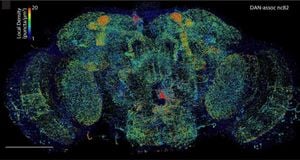Collective cell migration is fundamental to many physiological processes, including wound healing and tissue development. A recent study, published by researchers, sheds light on how intercellular adhesion influences this dynamic, demonstrating its surprising role as it relates to increased membrane tension.
When cells migrate, their behavior is often dictated by their interactions with neighboring cells. Traditional wisdom posited the importance of cadherins, the proteins connecting cell membranes, as the main actors uniting cells for coordinated movement. Yet, this new research suggests there is more to the story. By employing photoswitchable adhesion molecules, scientists were able to engineer artificial bonds between cells, allowing them to study the effects of varying intercellular tension without directly involving the cytoskeleton.
The findings reveal how linking adjacent cell surfaces significantly elevated membrane tension. According to the study, "Linking adjacent cells increases membrane tension, which activates the enzyme phospholipase D2." This enzymatic activation leads to increased levels of phosphatidic acid (PA), which significantly influences cell migration routes and speeds.
The researchers demonstrated through various experiments using human MDA-MB-231 cells, typically known for their weak intercellular adhesion, how these artificially created connections resulted not just in coordinated movement, but also enhanced individual cell motility. "We observed collective migration at the multicellular scale and increased motility at the level of individual cells," one of the authors commented, highlighting the dual nature of the findings.
Through cleverly elucidated methodology involving wound-healing assays, researchers tracked and analyzed cell movements under differing light conditions, showing rapid and coordinated edge migration when the cells adhered to each other under red light. Where traditional cadherins would have slowed cells due to increased friction, the artificial connections promoted speed and efficiency. The cells displayed behaviors characteristic of collective migration, even without the typical cytoskeleton linkages.
Crucially, the research introduces the concept of membrane-based signaling pathways as novel players in regulating collective cell behavior. With increased membrane tension, the mechanical coupling at cell surfaces appears to initiate subsequent biochemical signals involving mTOR pathways, previously known for their association with various cellular dynamic behaviors.
This is significant as it challenges existing perspectives on how cells interact and migrate together. The study suggests, unlike earlier models which placed cadherins and their linked cytoskeletal structures at the forefront, the properties of the plasma membrane itself can direct and modify how collective migration is executed—regardless of underlying cytoskeletal alterations.
The authors concluded with optimism about how these insights could inform future research: "The results suggest intercellular connections can influence not only collective migration but also the directional movement of individual cells."
This groundbreaking work offers considerable promise for advancements not just within cancer research—where cell migration plays an implicated role—but overall developmental biology, where cell dynamics are pivotal. More broadly, it paves the way for innovative approaches to manipulating cell behavior through engineered mechanical properties, establishing new avenues of study across cell biology and regenerative medicine.



